Building a gazebo roof can be an exciting and rewarding project for DIYers of any skill level. Gazebos are great additions to backyards and gardens, adding extra space for entertaining or relaxing outdoors. You can build a beautiful gazebo roof quickly by using the appropriate tools, materials, and instructions.
A gazebo roof is made up of several components including rafters, ridge boards, purlins and fascia boards. The type of material used will depend on the design you choose; wood is usually preferred as it’s easy to work with but metal roofs are also popular choices. You’ll also need to decide whether you want a flat or pitched roof before beginning construction.
How To Build A Gazebo Roof The Easy Way?
Once you’ve chosen your materials,’s time to get building! Start by measuring and the rafters to the appropriate. Attach these to the top of your posts using nails or screws and make sure they are properly secured. Next, add a ridge board at the peak of the gazebo roof. This board will provide support for the other components and should be securely fixed to the rafters using nails or screws.
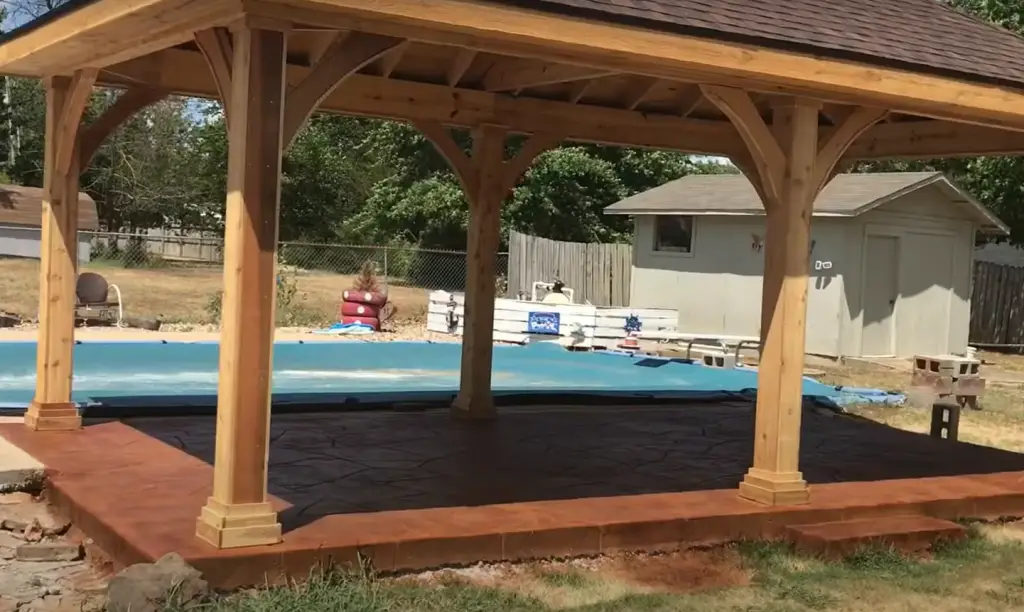
The purlins are next, these boards fit between the rafters and help add strength to your roof. You’ll need to decide how many you require depending on the size and shape of your gazebo. Secure the purlins to the rafters with nails or screws and make sure they are level.
Finally, attach fascia boards along the sides of your roof. These will help create a neat finish while also providing extra protection against water damage. If you’ve chosen a metal roof, it is important to ensure there are no gaps to prevent water from entering your gazebo.
Once all the components have been securely attached, you can begin to finish the roof. Choose a suitable material such as shingles, tiles or metal and attach them carefully in line with manufacturer’s instructions. To ensure extra protection against rain and snow, it is recommended to apply a sealant or waterproof coating.
Gazebo Roof Materials And Tools
To build a gazebo roof, you will require these tools and materials:
- Scissors or utility knife
- Tape measure
- Hammer & nails
- Screws screwdriver
- Drill with the appropriate drill bits
- Plywood for the roof frame and shingles
- Shingles (asphalt, wood or metal)
- Galvanized corner and ridge pieces
- Slats for the roof rafters and cross beams
- Warping strips to secure the roof frame together
- Joist hangers to support the rafters and joists
- Roofing felt for waterproofing the roof
- Caulk to seal joints and penetrations [1]
To begin constructing the roof of your gazebo, ensure that you have all the required materials.
Decide The Height And Direction Of The Top Ridge
To begin building a gazebo roof, you should first determine the desired height and direction of the top ridge. It is important to determine this correctly as it will impact the amount of space left for your design. You may find that calculating the angle of an existing structure in your garden helps you make these decisions.
Install The Rafters
The rafters are the boards that will support the gazebo roof.
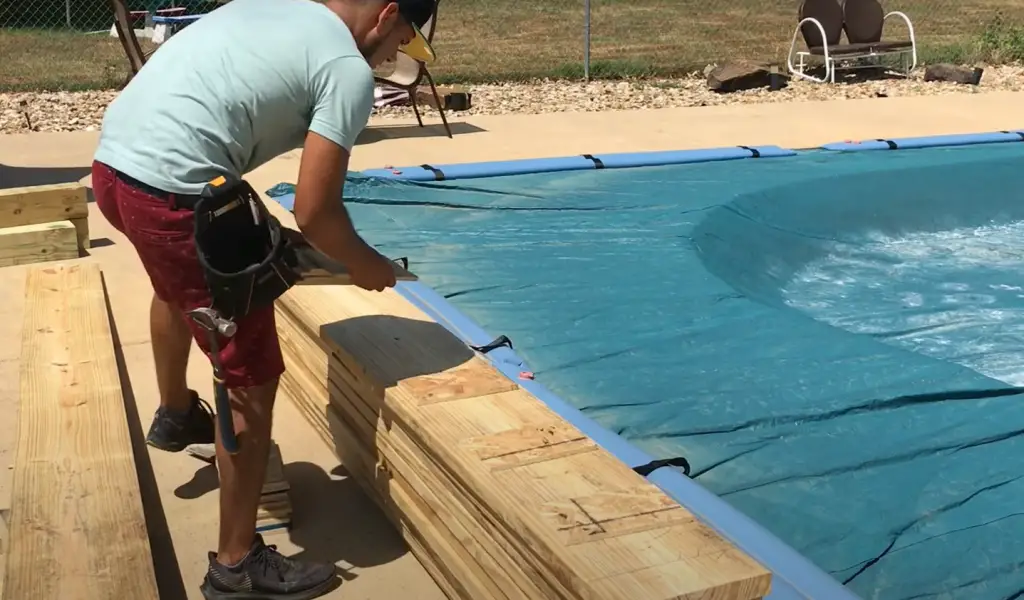
Depending on the size of your gazebo, you may install a few or many others. Begin by measuring and the necessary pieces for installation. Fit the rafter boards together at each corner and secure them with galvanized screws. Make sure to space the rafters evenly throughout the structure.
Cover The Roof With Plywood
The next step is to cover the roof with plywood.
Measure and mark where each piece will go before attaching them, making sure each board fits snugly against its neighbors and is flush with the rafters. To connect the boards, you’ll need to use a fastener such as screws or nails. Once the roof is covered with plywood, attach any additional trim around the edges for a finished look. Then apply roofing felt over the entire surface for added protection from moisture and wind. To finish building your gazebo, cover the roof with shingles or metal tiles. By properly planning and selecting appropriate materials, it’s possible to construct a long-lasting and attractive roof for a gazebo. [2]Place Asphalt Shingles On The Roof
Once the roof is constructed, you’re ready to start placing asphalt shingles. It’s important to make sure that you purchase enough shingles for your gazebo roof, so measure the size of the roof before purchasing. Additionally, make sure that the color and style of shingle match with the aesthetic of your gazebo. To install the shingles, start at the bottom and work your way up in rows. Begin by placing a starter strip along the edge of the roof and then add a row of full-length shingles with each successive row overlapping by about one-third. Every other course should be offset from the ones on either side in order to create a staggered pattern. To finish the roof, apply ridge cap shingles along the top of the peak of the gazebo and secure them with nails. Finally, it’s important to coat each shingle with a waterproof sealer for added protection from the elements. These steps and tips will help you construct a gazebo roof with ease, resulting in a beautiful final product. [3]
How To Build A Square Gazebo Roof?
Constructing a square gazebo roof is a straightforward task that can be completed within a few days. To construct a roof for your square gazebo, follow these steps:
Hip Rafters
To continue building the gazebo roof, you need to build the hip rafters. These should be cut at an angle according to the plans for your gazebo, then attached to the top of each corner post using joist hangers. The addition of hip rafters to the roof will enhance its stability and offer extra support during windy weather.

Once the hip rafters are installed, you can begin to install the remaining rafters. The rafters should be cut to size according to the plans and spaced evenly across the top of each corner post. Joist hangers should be used to attach each rafter securely to the posts, with nails placed at points along the rafter to prevent it from twisting.
Ceiling Joists
The ceiling joists are the rafters of your gazebo roof and should be cut from 2×6 lumber. You will need to use a miter saw to make 45-degree cuts on one end of each rafter so that it can join with the other rafters when you assemble them. Make sure the length of each rafter is at least two inches longer than the width of your gazebo.
Shingles
Once the roof frame is assembled, the next step is to install the roofing material. Asphalt shingles are a commonly used material for constructing a gazebo roof.
Installing shingles requires laying out the first row and then overlapping each subsequent row. Nail down the shingles on each row to secure them in place, being careful not to expose any nails or puncture any of the shingles. Additionally, some shingles may come with adhesive strips that should be used as well for extra security. Once all of the shingles are in place, they should be sealed with a waterproof sealant to protect them from the elements. [4]How To Put A Roof On A Gazebo That Will Last?
One of the most important aspects of constructing a gazebo is to ensure that it has a durable and long-lasting roof.
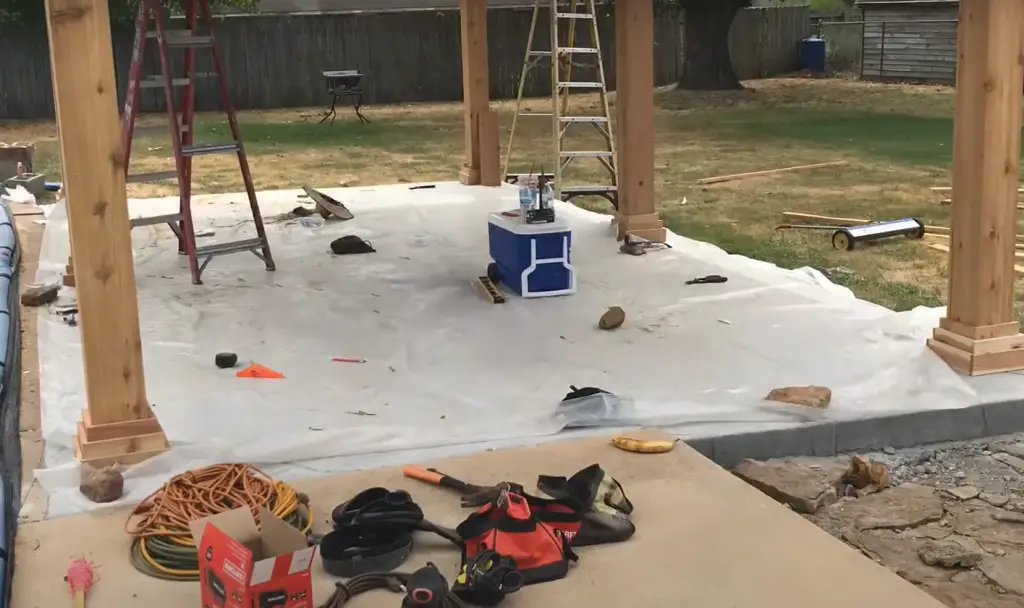
A good quality roof will protect your guests from rain, sun, debris and other elements. Here are some tips to make sure you build a reliable roof for your gazebo:
- Choose the right materials: To build a sturdy gazebo roof, it is crucial to choose materials that are both durable and resistant to weather conditions. Generally, metal and ceramic tile are the best choice for outdoor use. To ensure longevity, it is recommended to choose aluminum or steel material with a powder coating that offers extra protection against corrosion.
- Use roof trusses: To ensure your roof can withstand both wind and rain, you need to install roof trusses. Here, the load of the roof is evenly distributed across several points which provides a more stable base for your gazebo.
- Get professional help: Building a reliable gazebo roof is not an easy task, and it would be wise to seek professional help. A contractor can help you build a strong and durable structure that will last for years. [5]
FAQ
How do you build the roof gazebo?
Building a gazebo roof is not as difficult as it may seem. All you need is some basic carpentry skills, some tools and supplies, and a bit of time and patience. Here are the steps to follow:
- Measure your gazebo frame size and then cut four boards for the main roof frame.
- Cut and attach the rafters to the main roof frame using galvanized nails or screws.
- To make sure they are evenly spaced, use a framing square or level when installing the rafters.
- Attach the sheeting with galvanized nails to cover your gazebo frame and create a waterproof layer for your roof.
- If necessary, attach a ridge cap to the top of your roof for extra protection from the elements and a finished look.
- Finally, apply a sealant or coating as needed to ensure your gazebo roof is waterproof and secure for years of outdoor use.
What is the best roof for a gazebo?
The best roof for a gazebo is one that provides protection from the elements and looks great too. There are several types of roofs available, such as shingled, tin, aluminum and polycarbonate roofs. Each type has its own benefits and drawbacks to consider before making a decision. Shingled roofs are the most traditional, providing a classic look to any gazebo. Tin roofs are strong and durable, perfect for areas with heavy rain. Aluminum roofs provide a finish and can be treated to resist fading and cracking from sun exposure. Polycarbonate roofs are lightweight and impact-resistant, making them well suited for use in windy or snow-prone areas. Consider all of your options before choosing the best roof for your gazebo.
Is it cheaper to build your own gazebo?
The cost of buying a prefabricated gazebo from a retailer can be expensive, but building your own is often significantly cheaper. By constructing your own gazebo, you can customize the size and materials to fit your budget and preferences. Before starting, it’s important to consider the type of roof you want to build.
What kind of wood do you use for a gazebo roof?
The type of wood you use for your gazebo roof will depend on the overall design and size of the structure. Generally, cedar is a popular choice due to its resistance to rotting, warping, and splitting. Pressure-treated pine is also an option although it may require more maintenance than cedar.
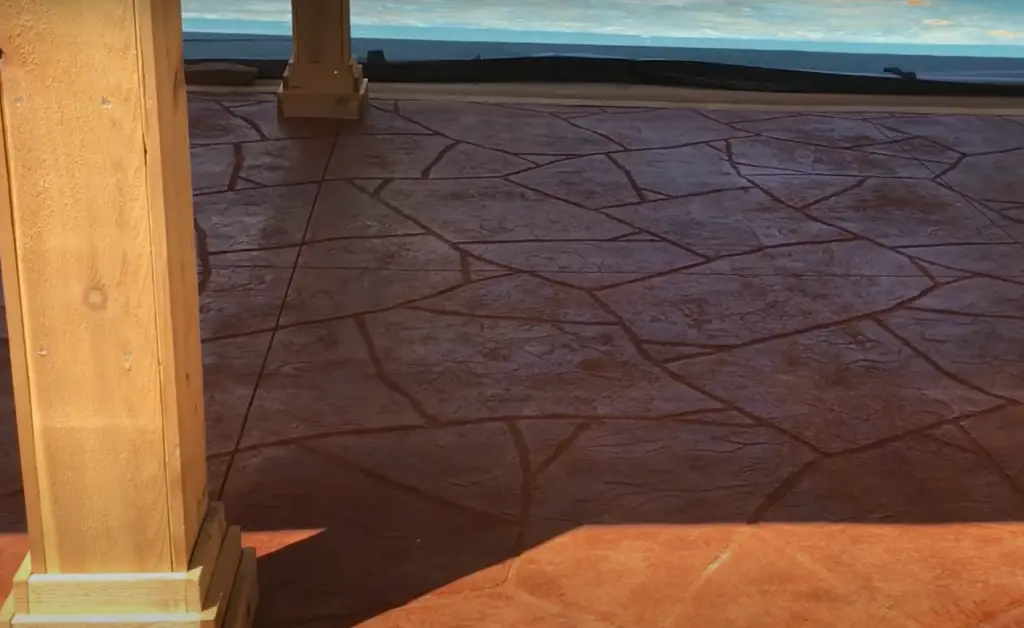
Redwood is another good choice due to its natural beauty, but it is more expensive than the other options mentioned. Alternatively, you can opt for composite material such as fiberglass or metal if you’re looking for a longer lasting and low maintenance option.
How high should a gazebo roof be?
Several factors should be considered when determining the height for a gazebo roof. Firstly, if you plan on using the gazebo for entertaining guests or hosting events, then a higher gazebo roof is necessary to give more headroom and space. Additionally, depending on the climate where your gazebo is being built, you may need to add extra height to account for snow and wind. The recommended gazebo roof height is 8-10 feet. This gives you enough space to walk around comfortably while also providing the right amount of protection from the elements. Ensure that the frame of the gazebo roof is sturdy enough to bear the extra weight from snow or wind.
How do you wind proof a gazebo?
Wind proofing a gazebo is important for comfort and protection from the elements. The roof of your gazebo should be strong and durable, but also designed to resist wind gusts. Here are some tips for wind-proofing your gazebo:
- Update your existing frame in order to make it more structurally sound. A sturdy frame is the first line of defense against strong winds.
- Use higher-performance fabric for your gazebo’s canopy. Look for a fabric that is tear resistant and can stand up to high wind speeds without breaking or shedding.
- Increase the height of your gazebo walls. Installing a taller wall will provide additional protection against winds and help keep debris from blowing into your gazebo.
- Install canopy supports along the perimeter of your roof. This will prevent the wind from lifting up your canopy and damaging it or causing it to fly away.
- Secure the canopy to the frame with straps or weights on the edges. This will prevent the canopy from rippling and billowing in high winds, which can cause damage to your gazebo. With these tips in mind, you’ll be able to enjoy a wind-proof gazebo for years to come!
What is the easiest roof style to build?
The easiest roof style to build for a gazebo is an-frame or hip roof. Both of these styles are simpler than more complex designs, with fewer cuts and angles. For example, an A-frame roof consists of two angled sides that come up from the walls and meet at the peak in the center, forming an upside-down “A” shape. This style is also very quick to construct and requires fewer materials than some other roof styles. In, a hip roof has four sides with equal angles that come up from the walls and meet in the center like an inverted pyramid. Hip roofs are slightly more complex to build than an A-frame roof, but the extra effort may be worth it for a more attractive finished product. Both of these styles are also very stable, providing excellent protection from wind and rain. No matter which style you choose, it’s important to make sure that your roof is securely fastened. Make sure that every joint has been properly reinforced with wood screws or nails and that the roof is securely connected to the walls. This will provide extra stability for your gazebo and help ensure it lasts for to come.
How thick should plywood be for a gazebo roof?
The thickness of the plywood used for a gazebo roof should depend on the size and weight of the completed structure.
To ensure the quality of your plywood, choose boards rated for exterior or marine use. These will resist moisture and environmental factors better. It is also important to choose wood with a high ply count, as this will add strength and stability. It’s important to keep in mind that thicker plywood comes with a higher price tag. However, choosing this option may ultimately be cost-effective if it helps to protect your gazebo from damage.What style roof is best for heavy rain?
There are various styles available for building a gazebo roof. For those living in areas with heavy rain and strong winds, a pitched or hipped style roof is the best option. The steep slope of the roof will help keep rain and debris away from the sides of the structure. Additionally, a pitched or hipped roof will better resist wind damage and water accumulation. Be sure to use thicker materials for this style of roof and inspect it regularly for any signs of wear or damage. Also, it is important to add flashing around chimneys and other roof penetrations. This will help protect the roof from water penetration and weather damage. However, this style of roof tends to be more expensive in both materials and installation costs.
Can I put a metal roof on my gazebo?
Yes, it is possible to put a metal roof on your gazebo. Metal roofs are often chosen for their durability and low maintenance requirements. However, they can be expensive and difficult to install.
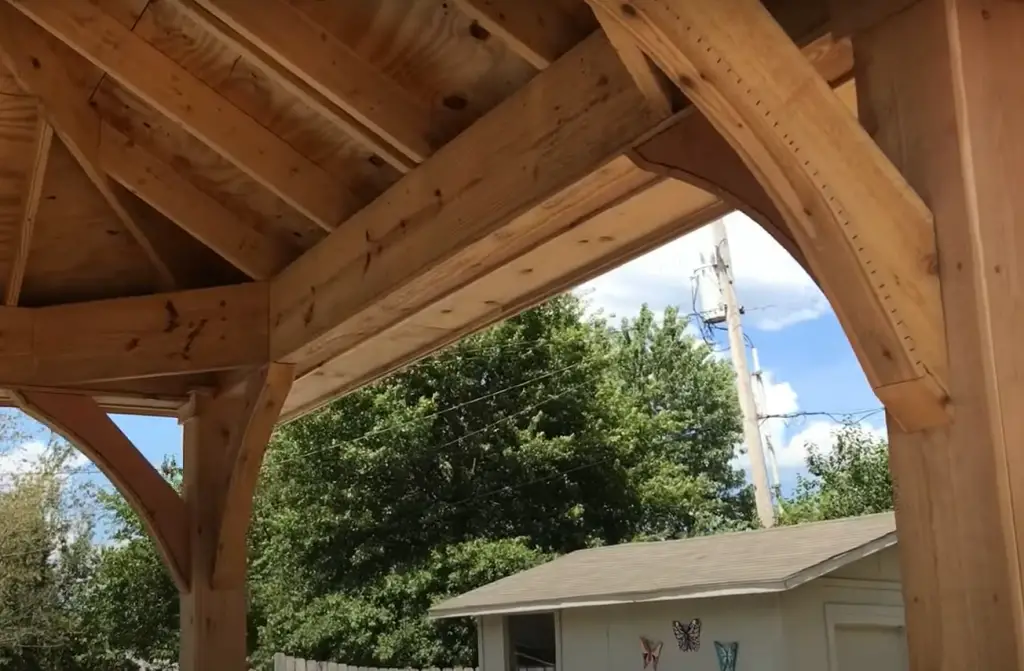
Make sure the gazebo can support the weight of the metal roof before you start the installation process. You should also take into account wind load, as a metal roof is much heavier than traditional gazebo roofs. When installing a metal roof on your gazebo, you will need to create a frame for the roof and secure it to the structure with screws or bolts. Once the frame is in place, you will need to attach the metal roof panels. You should use rubber gaskets or sealants between the panels and frame to ensure that they are securely attached and waterproof. When installing the metal roofing sheets, make sure that they overlap so that water cannot penetrate through any gaps.You may also want to consider adding a coating to the metal to protect it from UV and water damage. This coating will need to be reapplied periodically in order for it to remain effective.
Useful Video: Gazebo build, building a gazebo covered in cedar wood | how to build a gazebo
Conclusion
Building a gazebo roof is a relatively simple and enjoyable project that can be completed within a day or two depending on the size of the structure. As long as you have all of the necessary materials, tools, and some basic knowledge of carpentry techniques, you should be able to construct the roof without too much difficulty. Make sure to take time to plan out the design before you begin, as this will help ensure that your roof is strong and attractive. By taking good care of and regularly maintaining your gazebo roof, you can expect it to last for many years and provide you with an enjoyable experience.
References:
- https://www.gardenpatch.co.uk/how-to-build-a-gazebo-roof/
- https://myoutdoorplans.com/pergola/how-to-build-a-gazebo-roof/
- https://gardenplansfree.com/gazebo/gazebo-roof-plans/
- https://diydeckplans.com/how-to-build-a-deck/gazebos/gazebos-how-to-frame-your-gazebo-roof
- https://manabouttools.com/diy-timber-frame-gazebo-part-3/





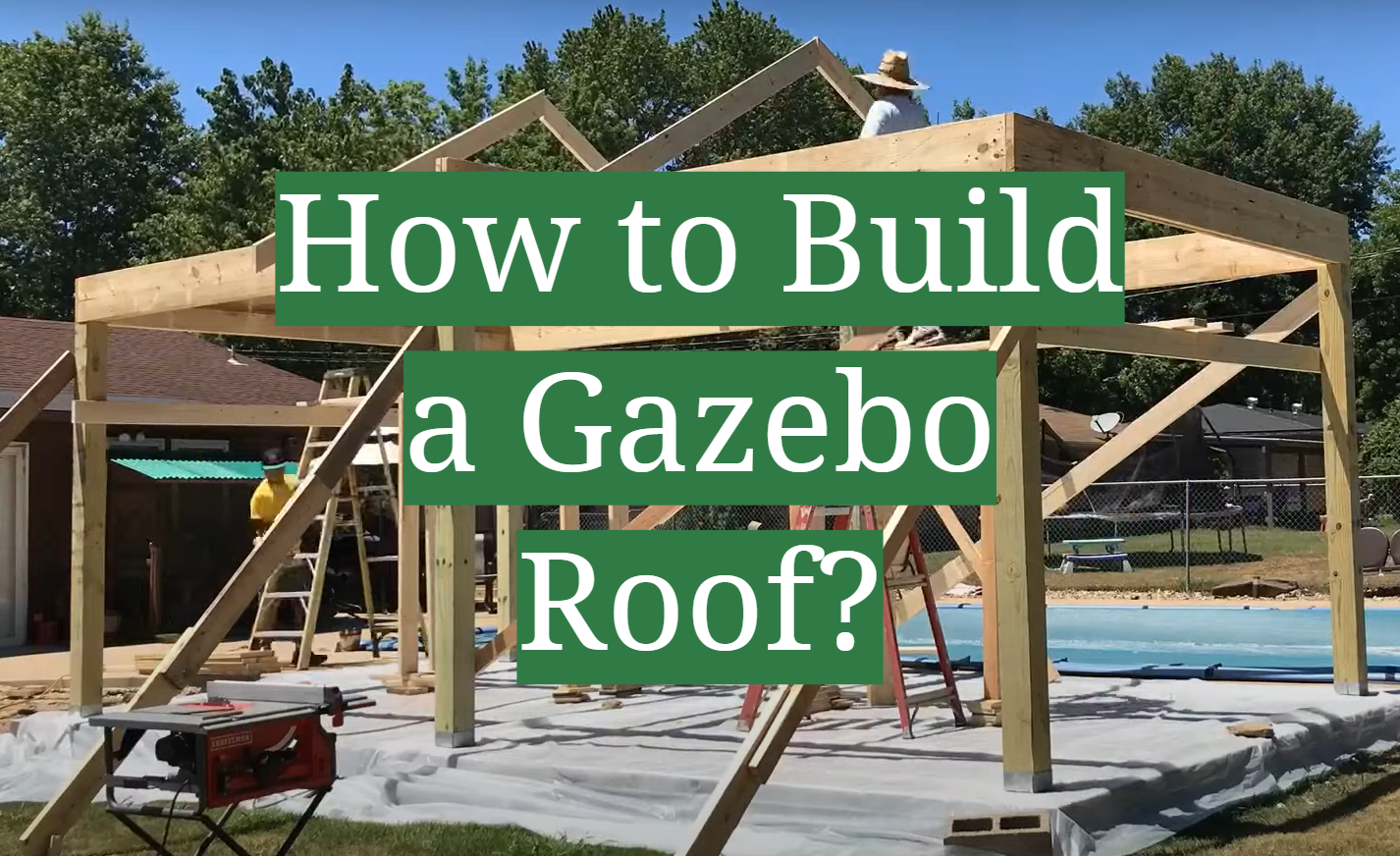



Leave a Reply
View Comments